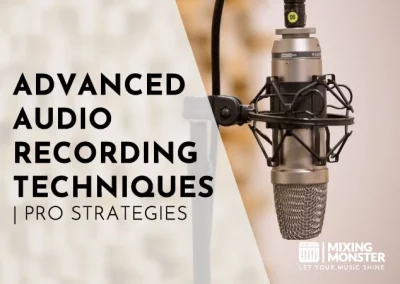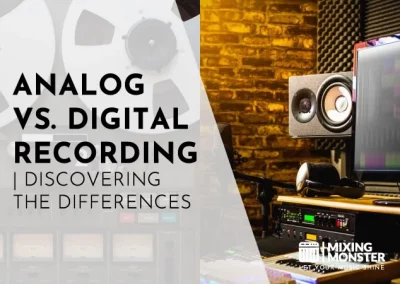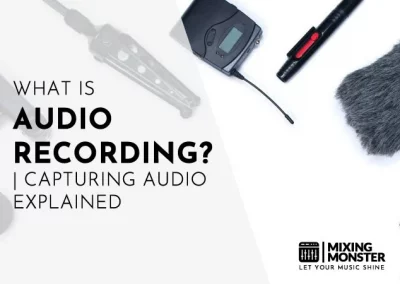Disclosure: Some of the links below are affiliate links, meaning that at no additional cost to you, we will receive a commission if you click through and make a purchase. Read our full affiliate disclosure here.
Capturing the essence of sound within a small studio’s confines presents its challenges and opportunities. Unearthing “recording secrets” becomes the game-changer for many engineers and producers striving to achieve professional-grade recordings without the luxury of large studio spaces. These techniques and insights bridge the gap between amateur efforts and release-quality output, offering a transformative edge even in compact recording environments.
Recording secrets for the small studio are the collective wisdom of industry professionals, serving to enhance the quality of audio recordings significantly. These techniques guide you through the nuances of capturing sound with precision and clarity. Proper audio recording improves the technical quality of recordings and enriches the creative process for artists and audio technicians.
In this article, you will uncover the essential practices that lead to superior recordings—practices curated for small studio environments but impactful nonetheless. Equipped with these insights, your path to crafting and refining your sonic creations is set to become clearer and more rewarding.
KEY TAKEAWAYS:
- Essential recording techniques can elevate small studio productions.
- Proper audio recording enhances audio quality in music production right from the start.
- These insights offer a clearer path to achieving professional-quality sound.
Table Of Contents
1. Introduction To Audio Recording Secrets
2. Audio Recording Secrets Revealed
3. Wrapping Up The Audio Recording Journey
4. FAQ

1. Introduction To Audio Recording Secrets
On your journey into audio recording, you’ll discover the precision and subtleties that transform good sound into great. From technical concepts to the finesse in mic technique, each aspect offers a piece of the puzzle to achieving stellar recordings.
Discover The Art Of Capturing Stellar Audio
Your endeavor in capturing exceptional audio begins with recognizing the importance of mic technique and the strategic use of multiple mics.
Celebrated engineers like Geoff Emerick and producers like Rick Rubin have pioneered techniques for a rich, full-bodied sound, setting the gold standard in audio recording.
- Mic Placement:
Finding the sweet spot that captures the essence of the sound. - Mic Selection:
Choosing the right microphone based on the character and dynamics of the audio source.
Understanding Audio Recording Fundamentals
Grasping the fundamental principles of audio recording sets a foundation for your effectiveness in the studio. Essential concepts such as signal flow, acoustics, and equalization are vital to manipulate and enhance your recordings.
- Signal Flow:
Understand the path from source to recording medium. - Room Acoustics:
Room acoustics can color or degrade your recordings.
What To Expect From These Proven Audio Recording Secrets
You’ll learn to maximize limited resources to produce big-studio-sounding tracks. Successful producers maximize every tool, often turning to innovative recording techniques to refine their sound.
By embracing these techniques, you’re on the path to capturing audio that resonates with clarity and depth, rivaling that of professional recordings.
2. Audio Recording Secrets Revealed
To achieve a commercial-grade recording, it’s essential to master a range of skills, from selecting the right microphone to understanding the nuances of digital formats. Applying these insider techniques will give your recordings a competitive edge regardless of the budget or equipment.
So here we go!
#1 Mic Selection Mastery
Choosing the right microphone for the task is foundational to capturing quality sound. Whether recording vocals or instruments, dynamic mics are robust and handle high volume well, while condenser mics are sensitive and ideal for capturing delicate nuances.
#2 The Art Of Mic Placement
Mic placement profoundly affects the sound. Even a few inches can change the tonal balance and presence of a recording. Experiment with placement—close for a rich, intimate sound or further away for more ambient capture.
#3 Harnessing Room Acoustics
Your recording room’s acoustics can be a powerful tool. Use baffling and diffusers to minimize unwanted echoes and reverb. Sometimes, improvised acoustics tweaks—like hanging blankets—can transform a space acoustically.
#4 Crafting The Ideal Recording Space
Design a space that serves your sound. Soft materials absorb high frequencies, reducing harshness. For low frequencies, consider bass traps in corners. This control leads to a more precise and balanced recording environment.
#5 Recording Signal Flow Fundamentals
Understanding signal flow is crucial for trouble-free recording. Trace the path from mic to monitor—know every equipment and cable in the signal chain. This knowledge helps in identifying and solving issues quickly.
#6 Gain Staging Gold
Proper gain staging is critical for noise-free recording. Set your levels so that the peak signal reaches about -6 dB. This ensures clear recordings without clipping or noise contamination from pushing the preamps too hard.
#7 Cable Quality Counts
Please pay attention to the importance of high-quality cables; they can prevent noise and signal loss. Investing in good cables is a simple way to elevate the audio fidelity of your recordings.
#8 Monitoring With Purpose
To make informed decisions, you must hear accurately. Use a pair of flat-response studio monitors or high-quality headphones in an acoustically treated room to reveal the authentic sound of your recording.
#9 Layering Vocals For Lushness
Layering vocals can add texture and depth. Record multiple takes and pan them across the stereo field for ensemble depth. Remember to account for phase issues that may arise from multiple layers.
#10 Acoustic Guitar Ambience
Place a mic near the 12th fret of an acoustic guitar to balance brightness and body. Consider the room’s reflectivity to add natural reverb or place another mic further away to capture the ambiance.
#11 Dynamic Drum Recording
Close mic each drum for clarity and mix with overhead mics for ambiance. Adjust phase relationships between mics for a tight, coherent drum sound. Real-world recording situations may require inventive solutions for mic placement due to space constraints.
#12 Electric Essence: Guitar & Bass
Direct injection (DI) and mic’ing the amplifier can record electric guitar and bass well. Use a dynamic mic close to the cab for punchiness and a condenser mic slightly further away for a fuller sound picture.
#13 Exploring Stereo & Mid-Side Mic Techniques
Stereo mic techniques, like X/Y or A/B, capture spatial detail and width. For adjustable stereo width post-recording, mid-side (M/S) technique is invaluable, especially in tricky acoustic environments.
#14 Phase Coherence Clarity
To ensure clarity in your recordings, always check for phase issues. This is particularly important in multi-mic setups like drum kits. Inverting the phase of a mic can correct cancellations and preserve the fullness of the sound.
#15 Commanding Compression
Use compression to control dynamics, but employ it judiciously. Over-compression can sap life from a performance. Aim to smooth peaks while maintaining the natural dynamics of the source material.
#16 EQ For Excellence
EQ can shape and enhance the sound. High-pass filters remove unwanted lows from non-bass instruments, while selective boosts and cuts allow for instruments to sit well together in the mix.
#17 Reverb And Delay Dimensions
Reverb and delay can place a recording in a virtual space. Subtle use can add depth without muddiness. The key is to blend effects naturally as if they were part of the recording environment.
#18 Precision Editing
Tight, meticulous editing can elevate good takes into great ones. Remove extraneous noises, align timing between tracks, and create the perfect comp take carefully to preserve performance authenticity.
#19 Vocal Tuning Tact
When tuning vocals, the aim is to correct pitches subtly without losing the singer’s expression. Software like Melodyne lets you adjust pitch while retaining the nuances that give a vocal character.
#20 DAW Workflow Wizardry
Learning the ins and outs of your DAW can save hours. Custom key commands, templates, and an understanding of routing and grouping tracks can streamline your recording and mixing process.
#21 Virtual Instruments & Plugins Power
Software instruments and plugins offer immense creative flexibility. Use them to complement real instruments or create entire arrangements when access to physical instruments is limited.
#22 Automation For Animation
Automation is a powerful tool to add dynamism to your mix. Automate levels, panning, and effects parameters to reflect the energy and movement of the recording.
#23 Live Performance Capture
Capturing a live performance requires preparation and adaptability. Check and double-check all equipment, record a soundcheck, and be prepared to make adjustments on the fly for the best result.
#24 Field Recording Finesse
Field recordings can add unique textures to your productions. Use a portable field recorder and be mindful of the environment to capture clean, usable sounds.
#25 Remote Recording Resilience
Remote recording sessions present unique challenges. Have a reliable recording setup, good internet connection, and clear communication with the talent to ensure a successful session.
#26 Archiving Audio Assets
Maintain a structured archive of your recordings—label, and store files descriptively to retrieve them easily for future projects or additional production phases.
#27 Decoding Digital Formats
Understand the differences between digital audio formats like WAV, AIFF, MP3, and FLAC. Choose the appropriate format for recording, editing, and distributing your music based on quality needs and file size constraints.
#28 Tracking Tech Trends
Stay informed about evolving recording technologies. Embrace innovative tools that can enhance your recordings, from new plugins and virtual instruments to advances in digital audio workstations.
#29 Vocal Recording Virtuosity
For vocals, use a pop filter to reduce plosives and a reflective filter to contain the voice. To capture their best take, guide the performer with psychological tricks, like dimming lights, for a more intimate performance. Understanding the proximity effect can also enhance your vocal recordings.

3. Wrapping Up The Audio Recording Journey
As your recording journey progresses, applying newly learned techniques effectively, continuously adapting to the evolving landscape of audio recording, and embracing creativity will mark your growth as an engineer or artist.
Implementing New Recording Secrets
You’ve acquired a wealth of techniques by studying these recording methods inspired by experts such as Steve Albini and Geoff Emerick. It’s now crucial to apply these to your work.
Begin with basic vocal recording, using a single-mic approach to understand the human element in the recording. As you grow more confident, experiment with one source multiple mics techniques for different instruments like clarinets and flutes.
This is how you take the step from absorbing knowledge to putting it into practice.
The Continuous Learning Curve Of Audio Recording
The field of audio recording is vast and ever-changing. Icons like Roy Thomas Baker or Eddie Kramer exemplify the heights one can reach with dedication.
Your journey will involve frequently visiting resources for further reading and challenging yourself with new situations, like multi-micing in stereo or capturing the nuance of acoustic guitar. Remember, the multitrack download library is an excellent tool for practice.
Experimentation And Creativity In Your Recordings
Finally, immersing yourself in the craft means opening up to experiments. Let your creative instincts lead, whether it be multi-micing a kick drum or trying unconventional methods like ensemble recording with peer arrays.
Professionals like Tchad Blake and Bob Rock didn’t become renowned by staying within the lines—they explored audio recordings in expressive and groundbreaking ways. Recording formats such as MP3 and WAV offer different experiences, so experiment to find your unique sound.
Remember to constantly revisit the wisdom of seasoned engineers like Jack Joseph Puig and Tony Visconti to stay inspired and innovative.
Audio recording is an art and requires a deep understanding of technical aspects and a ton of experience. It is the foundation of the music production process and the source of audio excellence!
Happy recording!



















